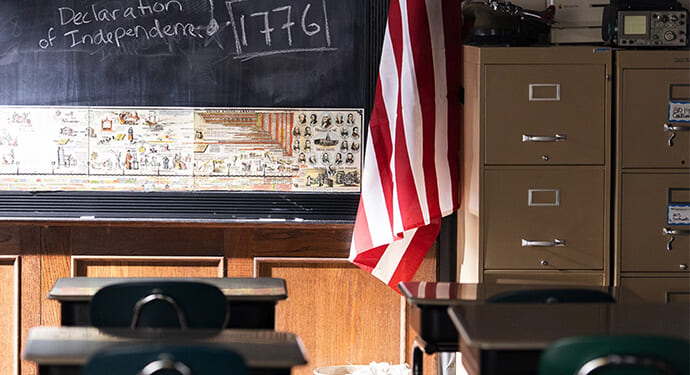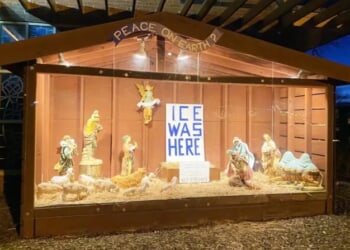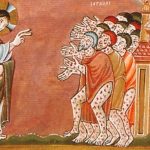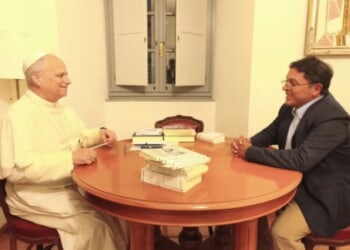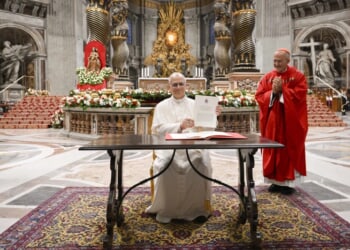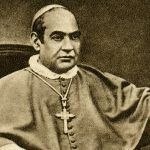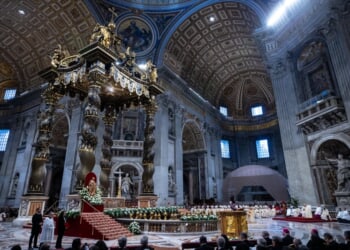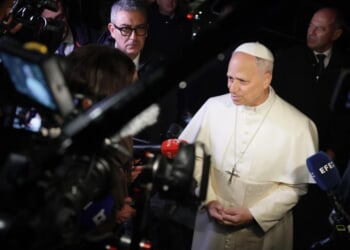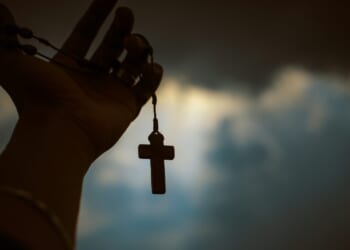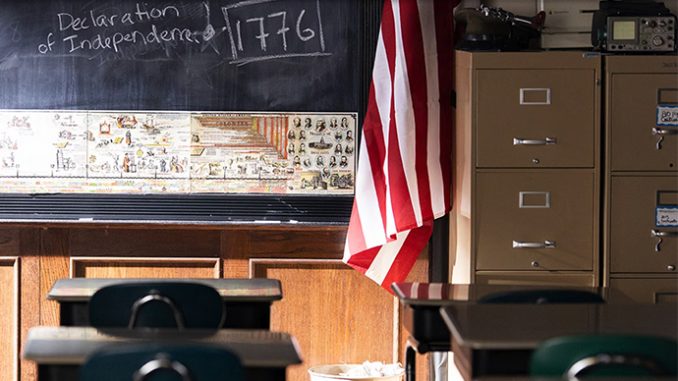
In my previous essay, I proposed the idea of a “1531 Project” as a possible Catholic intervention into the contemporary culture wars over how properly to tell the story of American history. In this essay, I would like to provide a more specific sense of a Catholic interpretation of American history through a critical engagement with Hillsdale College’s “The Great American Story: A Land of Hope.”
A major undertaking in public history, produced in cooperation with the current presidential administration, “The Great American Story” stands as the most significant alternative to a mainstream academic history judged rightly by many conservatives to be too critical of America for its faults and unwilling to acknowledge its virtues and positive achievements. Such a challenge is long overdue, and those who believe that vigorous debate is essential to a vibrant intellectual life should welcome the appearance of an alternative voice in the study of American history. Patriotic Americans in particular may heave a collective sigh of relief to finally have a serious account that sees American history as something more than a catalog of the sins of dead white men.
High stakes, grand remarks
All good history requires a certain critical yet sympathetic understanding of the past. Historians must first understand the past in its own terms and resist the temptation to impose current standards—and judgments—on historical actors living in places and times far different from our own.
This first rule of historical inquiry has largely been abandoned by the scholars lending their authority to endeavors such as “The 1619 Project.” The scholars behind “The Great American Story” are to be commended for insisting on adherence to this basic first principle. (The online course is free, and I encourage all interested in these matters to watch the video lectures.)
Still, the Hillsdale project aspires to far more than restoring balance and integrity to the study of history. The introductory lectures by President Larry Arnn and historian Wilfred McClay make clear that the stakes of American history are far grander than honest scholarship. Here is the point at which a Catholic student of history should take pause. President Arnn is not content to describe the American Revolution as the Founding of America. No, it is nothing less than “a fulfillment of things that humans have hoped for from time immemorial.” Really? Hmm, I thought that privileged position belonged to Jesus Christ.
Arnn’s comments cannot be dismissed as exaggerated rhetoric. The problem is not simply that he privileges America, but that he reads all human history through the lens of modern politics. In doing so, Arnn simply follows the conceit of the standard narrative of “Western” history that developed during the nineteenth century, as scholars scoured archives to trace the historical development of the modern nation-state. Distilled into textbooks for easy undergraduate consumption, the story of the West became the story of “freedom.” Despite this framework, as the textbooks themselves make clear, freedom has been present only by its absence for most of the history of the West. Aside from a few fleeting attempts at republican government in the ancient world, rule by a landed, warrior aristocracy has been the norm up to the late 18th century.
Most people simply accepted this as the way of the world, the way things had always been, and the way they always would be. Even such a Roman patriot as St. Augustine could look at the world of nations and see mostly a story of a lust for wealth, power, and glory. Enlightenment thinkers such as the Founding Fathers did indeed look for inspiration in those brief republican moments of the ancient world. They certainly understood political liberty as the longing of the ages, but in that they were perhaps the first generation to do so.
Prior to the Enlightenment, European Christians saw Jesus Christ as the longing of the ages and accepted some version of earthly monarchy as an appropriate political analogy to the kingdom of God in heaven.
“Hope” for what?
Lest I be accused of confusing politics and religion, Professor McClay makes clear that America is much more than a system of government: “it is not a material thing, it is a spiritual thing.” McClay states this in the context of explaining the concept of “hope” that appears in the subtitle of the course and Land of Hope, the title of his book on which the course is based.
At one level, his observation that people came to the New World hoping for a better life is unobjectionable; however, to see this better as a “spiritual” ideal is to read a post-revolutionary ideal back into the colonial period. The better life that most colonial immigrants longed for was decidedly material. Conquistadors and other adventurers aside, the humble subsistence dirt farmer came to America because there was no available land left in Europe. He came seeking not to create a whole new way of living, but simply to live the traditional life of a farmer denied him in Europe due to a lack of access to land.
The minority of colonists who did emigrate for “spiritual” reasons hoped not for a new way of living but simply the freedom to live the Christian life as they understood it. The Puritans who founded the Massachusetts Bay Colony imagined themselves as a “city on a hill” in the sense of a model Christian community whose example would inspire England to return to the pure Christianity of the Apostolic Age. Yes, this aspiration reflects a kind of hope, but not the forward-looking hope McClay invokes with his title.
Despite its Calvinist theology, the original Puritan “hope” actually provides the strongest point of intersection between Catholicism and early American history. “A Modell of Christian Charity” (1630), the “lay sermon” in which John Winthrop laid out his founding vision for the Puritan life in Massachusetts Bay, reflects nothing if not the traditional, medieval Catholic understanding of the hierarchical ordering of society:
GOD ALMIGHTY in his most holy and wise providence, hath so disposed of the condition of mankind, as in all times some must be rich, some poor, some high and eminent in power and dignity; others mean and in submission. . . . [God] delighted to show forth the glory of his wisdom in the variety and difference of the creatures, and the glory of his power in ordering all these differences for the preservation and good of the whole. . . . [God so ordered world] that every man might have need of others, and from hence they might be all knit more nearly together in the Bonds of brotherly affection.
This vision appears nowhere in Hillsdale’s “Great American Story.” In one sense, its omission is justified by historical fact: this organic vision of the body politic played little role in the subsequent story of the colonies and the United States because New World conditions made it nearly impossible to maintain the stable social order of the settled societies of Europe.
In another sense, its omission reflects an affirmation of the alternative social/political principle that replaced this traditional social order: something the Hillsdale historians call “self-rule.” Organic unity in charity, far from a principle by which to judge subsequent developments, would indeed appear to be irrelevant to the great American story of the advance of equality in liberty.
The relationship between charity and liberty
As a historian who is a Catholic, the contrast between these two social visions raises the question: What exactly is the relation between charity and liberty in the history of the United States?
The Church long ago made its peace with modern politics; charity and liberty need not be mutually exclusive. The weight of Catholic social teaching insists that both are necessary. More provocatively, the Church also insists that hierarchy of some kind, particularly in the areas of faith and family, remains essential to sustaining a social order directed toward the common good.
The concept of “self-rule” that links the early lectures of Hillsdale’s narrative provides no such caveats or limits. The term itself is curiously, even dangerously, open-ended. Why not invoke much more limited concepts, such as republican government or one-man, one-vote democracy? No doubt Hillsdale’s well-known libertarian sympathies play a part: this is, after all, a college that boasts a statue of Margaret Thatcher, who famously once declared, “There is no such thing as society!” So too, the Hillsdale historians wish to minimize the novelty of the American Revolution by rooting it in centuries-old English traditions such as “the rights of Englishmen”; “self-rule” obscures America’s decisive break with monarchy.
To this Catholic historian, the term also ironically evokes notions of the radical autonomy at the heart of the culture wars that prompted Hillsdale’s Great American Story project. No one should know this better than Professor McClay, whose prize-winning first book, The Masterless: Self and Society in Modern America (1994), addressed this very topic. The book is subtle and nuanced; it reflects, in many ways, the same ambivalence about radical autonomy that it analyzes as a historical problem. No doubt “self-rule” meant something much more limited in colonial America than in modern America. Still, as early as the first generation of New England Puritans, we see anticipations of the quest to be “masterless.”
Significantly, the first challenges were not in the realm of politics but in the area of religion. The Great American Story credits the Reformation with helping to advance the ideal of “self-rule.” The Puritans celebrated the break from Rome and challenged the Church of England to discard its Romish practices and doctrines to conform to their vision of a purified Christianity. John Winthrop would see his own authority similarly challenged within a few years of arriving in New England. Two dissenters within his community, Roger Williams and Anne Hutchinson, accused the Puritan ministers of failing to teach a pure doctrine concerning the relation between faith and works, the key issue that led to the Protestant break from the Catholic Church. Hutchinson went so far as to claim that the Holy Spirit spoke directly to her and that no minister held any authority over her. Masterless indeed.
Williams and Hutchinson were outliers in the 17th century. Both were condemned and exiled. The Massachusetts Bay Colony prospered. Puritans morphed into Congregationalists yet remained the established Church in the colony up to the Revolution and into the early Republic. Church establishments kept a lid on dissent within each colony; outside of Quaker Pennsylvania, “religious freedom” in the modern sense did not exist. Still, starting in 1765, the colonies would see a replay of the Williams/Hutchinson conflict in the area of politics: rather than a single believer telling a minister the true meaning of the Bible, the colonies would unite in telling Parliament the true meaning of “the rights of Englishmen.”
More on this in my next installment.
If you value the news and views Catholic World Report provides, please consider donating to support our efforts. Your contribution will help us continue to make CWR available to all readers worldwide for free, without a subscription. Thank you for your generosity!
Click here for more information on donating to CWR. Click here to sign up for our newsletter.

